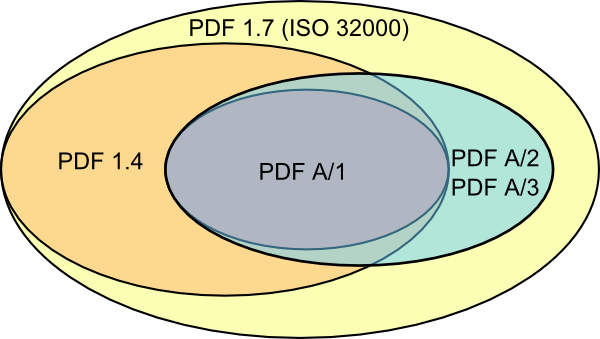When (not) to migrate a PDF to PDF/A
It is well-known that PDF documents can contain features that are preservation risks (e.g. see here and here). Migration of existing PDFs to PDF/A is sometimes advocated as a strategy for mitigating these risks. However, the benefits of this approach are often questionable, and the migration process can also be quite risky in itself. As I often get questions on this subject, I thought it might be worthwhile to do a short write-up on this.
PDF/A is a profile
First, it’s important to stress that each of the PDF/A standards (A-1, A-2 and A-3) are really just profiles within the PDF format. More specifically, PDF/A-1 offers a subset of PDF 1.4, whereas PDF/A-2 and PDF/A-3 are based on the ISO 32000 version of PDF 1.7. What these profiles have in common, is that they prohibit some features (e.g. multimedia, encryption, interactive content) that are allowed in ‘regular’ PDF. Also, they narrow down the way other features are implemented, for example by requiring that all fonts are embedded in the document. This can be illustrated with the following simple Venn diagram below, which shows the feature sets of the aforementioned PDF flavours:

Here we see how PDF/A-1 is a subset of PDF 1.4, which in turn is a subset of PDF 1.7. PDF A/2 and PDF A/3 (aggregated here as one entity for the sake of readability) are subsets of PDF 1.7, and include all the features of PDF A/1.
Keeping this in mind, it’s easy to see that migrating an arbitrary PDF to PDF/A can result in problems.
Loss, alteration during migration
Suppose, as an example, that we have a PDF that contains a movie. This is prohibited in PDF/A, so migrating to PDF/A will simply result in the loss of the multimedia content. Another example are fonts: all fonts in a PDF/A document must be embedded. But what happens if the source PDF uses non-embedded fonts that are not available on the machine on which the migration is run? Will the migration tool exit with a warning, or will it silently use some alternative, perhaps similar font? And how do you check for this?
Complexity and effect of errors
Also, migrations like these typically involve a complete re-processing of the PDF’s internal structure. The format’s complexity implies that there’s a lot of potential for things to go wrong in this process. This is particularly true if the source PDF contains subtle errors, in which case the risk of losing information is very real (even though the original document may be perfectly readable in a viewer). Since we don’t really have any tools for detecting such errors (i.e. a sufficiently reliable PDF validator), these cases can be difficult to deal with. Some further considerations can be found here (the context there is slightly different, but the risks are similar).
Digitised vs born-digital
The origin of the source PDFs may be another thing to take into account. If PDFs were originally created as part of a digitisation project (e.g. scanned books), the PDF is usually little more than a wrapper around a bunch of images, perhaps augmented by an OCR layer. Migrating such PDFs to PDF/A is pretty straightforward, since the source files are unlikely to contain any features that are not allowed in PDF/A. At the same time, this also means that the benefits of migrating such files to PDF/A are pretty limited, since the source PDFs weren’t problematic to begin with!
The potential benefits PDF/A may be more obvious for a lot of born-digital content; however, for the reasons listed in the previous section, the migration is more complex, and there’s just a lot more that can go wrong (see also here for some additional considerations).
Conclusions
Although migrating PDF documents to PDF/A may look superficially attractive, it is actually quite risky in practice, and it may easily result in unintentional data loss. Moreover, the risks increase with the number of preservation-unfriendly features, meaning that the migration is most likely to be successful for source PDFs that weren’t problematic to begin with, which belies the very purpose of migrating to PDF/A. For specific cases, migration to PDF/A may still be a sensible approach, but the expected benefits should be weighed carefully against the risks. In the absence of stable, generally accepted tools for assessing the quality of PDFs (both source and destination!), it would also seem prudent to always keep the originals.
Originally published at the Open Preservation Foundation blog
-
PDF
- VeraPDF parse status as a proxy for PDF rendering: experiments with the Synthetic PDF Testset
- Identification of PDF preservation risks with VeraPDF and JHOVE
- On The Significant Properties of Spreadsheets
- PDF processing and analysis with open-source tools
- Policy-based assessment with VeraPDF - a first impression
- PDF/A as a preferred, sustainable format for spreadsheets?
- Why PDF/A validation matters, even if you don't have PDF/A - Part 2
- Why PDF/A validation matters, even if you don't have PDF/A
- When (not) to migrate a PDF to PDF/A
- Identification of PDF preservation risks: analysis of Govdocs selected corpus
- Identification of PDF preservation risks with Apache Preflight: the sequel
- What do we mean by "embedded" files in PDF?
- Identification of PDF preservation risks with Apache Preflight: a first impression
- PDF – Inventory of long-term preservation risks


Comments